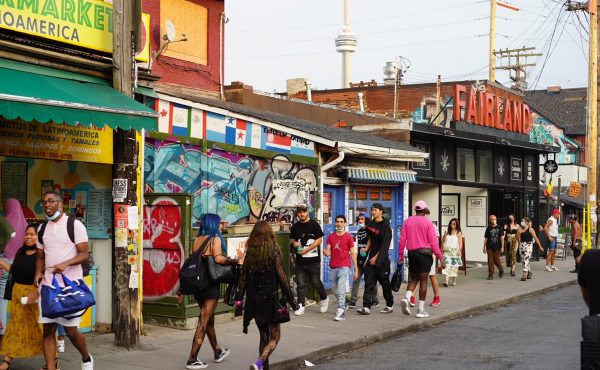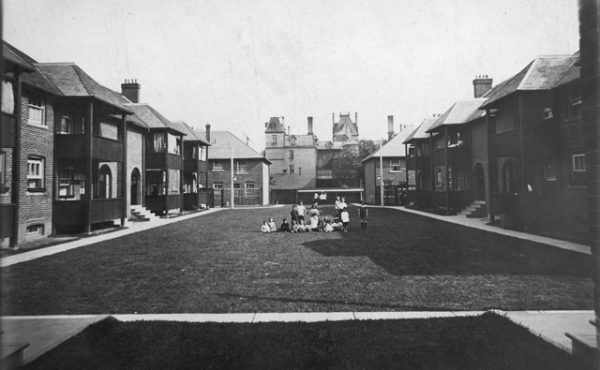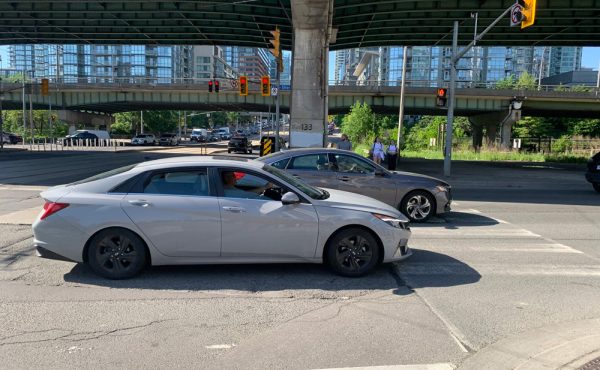Humanizing and humanely utilizing the endless stream of data coming out of cities may be a 21st century urban planner’s greatest challenge. Eyes on the screen has become almost as fundamental as eyes on the street to understanding how cities function.
Helle Soholt, a partner at Gehl Architects, re-emphasized this message a couple weeks ago in a talk at the Design Exchange on urban design and transportation planning. It’s a message Gehl has been pioneering for decades but is only beginning to catch on more broadly.
The City of Toronto is ahead of the curve compared to most governments with its fantastic Open Data portal. Recently, a dataset was uploaded that caught my eye for being particularly Gehlian in its focus on people. It compares pedestrian and vehicle volumes at intersections throughout the city. I’ve taken a first pass at this dataset by mapping this information as the amount of pedestrians at intersections during certain 24 hour periods (in blue) and the ratio of pedestrians to vehicles (colour-coded) during that period (each intersection was measured on a different day at some point between 2007 and 2011).
Before drawing any findings from these maps, there are a few problems with the data. First, each intersection’s volume counts were gathered on a different day. This means that some were counted during the summer, some the winter, some possibly with major construction nearby and some potentially after the opening of several new condo or office towers. The weather wasn’t recorded and it’s impossible to say what kind of human error may have been a factor in arriving at the final 24 hour figures. Because of these issues, comparing one point to another is problematic.
Regardless, a few things stood out for me:
a) All intersections that had a higher volume of pedestrians than vehicles counted are in the downtown core except for on Yonge Street at Eglinton and at St. Clair.
The intersections with the highest pedestrian volumes counted during a 24 hour period were
1. Yonge and Dundas – 96,674 (2008)
2. Yonge and Eglinton – 81,480 (2011)
3. Bay and Queen W – 77,630 (2011)
4. Jarvis and King E – 75,438 (2011)
5. Bay and Dundas W – 71,170 (2009)
b) Of the 15 intersections counted on Yonge Street between Bloor and King, 12 had higher pedestrian volumes than vehicle volumes during a 24 hour period, with as much as 3 times the volume of people than vehicles at Gould Street and Dundas.
The intersections with the highest ratios of pedestrian-to-vehicle volume during a 24 hour period were
1. Yonge and Gould – 2.96 pedestrians to 1 vehicle (2007)
2. Yonge and Dundas – 2.93 (2008)
3. Jarvis and King E – 2.14 (2011)
4. Queen W and John – 2.10 (2009)
5. Dundas W and Chestnut St – 2.07 (2011)
Outside the downtown core, the city is mostly filled with intersections that, despite large numbers of people in some places, are dominated by vehicles (the exception is on the York University campus).
While the downtown cluster of intersections dominated by pedestrians is interesting, equally compelling are the high pedestrian volumes at suburban intersections seemingly dominated by vehicles. If these numbers were combined with cycling counts or TTC ridership, the story might get more compelling still.
These numbers call to mind the familiar idea of pedestrianizing downtown streets like Yonge as well as a new idea of applying a concept like the TTC’s ‘crowding standards’ — where the level of service (number and frequency of buses, trains or streetcars) must be set by an objective formula based on ridership (a.k.a crowding) levels — to street design standards, particularly in the suburbs. With complete streets on all major arterials remaining an ultimate goal, formulas could be set mandating certain ‘design minimums’ required for safety purposes at intersections with a certain volume of people, irrespective of their ratio to vehicles.













7 comments
Great article Jake, We are preparing to launch a dynamic solution to humanize traffic counts at intersections, and I believe it’ll be very useful to discuss and collaborate with other like-minded professionals to improve the downtown pedestrians mobility access. I look forward to discuss in the near future.
This is gorgeous, and wonderful. Thanks Jake.
This data and mapping is a great start, and should be continued to include the corrections you mention: data to compare each day of the week, and year; include cyclists and transit, etc. Once that is done, it should be the major resource for street planning: each human should get the priority they deserve in that space, not each vehicle. Of course, I am biased: I own no car, though use Autoshare.
One other aspect of these stats worth looking at is the volume of pedestrian traffic versus land use. For example, there are four streets through, broadly speaking, The Beach — Queen, Kingston Rd, Gerrard and The Danforth. Only Queen and Danforth have all-day volumes big enough to get past the smallest under 5k/day level. Even with relatively low amounts of traffic, it’s not hard for the auto:pedestrian ratio to be high. The flip side of this on Queen is that it’s a street noted for both congestion and the fact that it doesn’t really go anywhere. Therefore the auto traffic tends to be local as opposed to the Danforth where the road serves as an arterial. Queen manages to get orange dots even though it has low all-day pedestrian volumes. Some suburban locations have high pedestrian counts, but even higher auto counts (the roads are bigger after all) that keep the ratios down.
It would be really interesting to see data subdivided by time of day. I am quite sure there are intersections that are busy either as pedestrian or auto locations for most of the 24 hours, and others where the ratio changes substantially by time of day and day of week.
All that said, the pattern of higher pedestrian activity relative to autos in the denser, mainly older parts of the city is clear, and with it the inevitable problem that pedestrian advocacy runs into a wall elsewhere.
These trends interestingly match in a similar way with a map of the density of road intersections in the GTA, where intersection density is sometimes used as an indication of walkability.
Check out the map here: https://visualizingurbanfutures.wordpress.com/2012/08/01/intersection-density-in-the-gta/
In response to ἈΝΤΙΣΘΈΝΗΣ’s comment, yes, this could be a major resource for street planning, but I think the other side of the equation is where in the city is there latent demand for pedestrian trips that are currently not happening due to lack of infrastructure.
There has to be a balance in focusing our planning and infrastructure investment towards both: 1) areas of the city where a lot of people are walking today 2) areas of the city where there’s potential demand for walking (e.g. areas where a higher proportion of residents don’t have access to personal vehicle, or where there’s relative high concentration of children and elderly, and the kinds of services and destinations they need to travel to). The two are not mutually exclusive, but looking at existing demand alone would miss some under-services parts of the city from a pedestrian infrastructure perspective (less walkable streets).
I think a couple of things are worth noting here.
Firstly, a distinction should be made between areas that generate a substantial number of pedestrian trips, vs. localized points where a lot of pedestrians are observed. Outside of the downtown core and other parts of the original Toronto, most of the intersections that show up as having more than 5k pedestrians per day seem to correspond to major TTC transfer points, between high-frequency and high-ridership routes. These points generate a lot of localized pedestrian activity, but not much 100 metres once you get away from the intersection. People are getting off one bus, crossing the road and getting on another bus. We can’t easily subtract TTC transfer activity from these numbers, but it would be interesting to see what the pedestrian levels would be like if they didn’t include people who would not be walking in that area if not to change from one TTC bus to another.
That’s not to say that isolated TTC-related pedestrian hotspots aren’t important, but one needs to be aware that they have different characteristics than areas that generate a lot of pedestrian activity on their own, and be careful in the conclusions that one draws from the data. The intersections have different characteristics too — they are often the busiest, the widest, and have the greatest likelihood for advance left turn signals.
Secondly, I believe there is a distinction between the pedestrian and automobile numbers. Automobile traffic includes all vehicles entering the intersection (including left and right turns). Pedestrian traffic only considers pedestrians crossing the road. A pedestrian crossing the intersection diagonally uses two crosswalks and will count as two pedestrians. A pedestrian that travels around the corner without crossing the road is not counted at all.